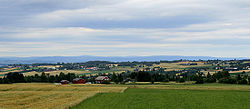Østre Toten
| Østre Toten kommune | |||
|---|---|---|---|
| Municipality | |||
 |
|||
|
|||
 Østre Toten within Oppland |
|||
| Coordinates: 60°36′48″N 10°54′58″E / 60.61333°N 10.91611°ECoordinates: 60°36′48″N 10°54′58″E / 60.61333°N 10.91611°E | |||
| Country | Norway | ||
| County | Oppland | ||
| District | Toten | ||
| Administrative centre | Lena | ||
| Government | |||
| • Mayor (2015) | Guri Bråthen (Ap) | ||
| Area | |||
| • Total | 562 km2 (217 sq mi) | ||
| • Land | 486 km2 (188 sq mi) | ||
| Area rank | 189 in Norway | ||
| Population (2004) | |||
| • Total | 14,657 | ||
| • Rank | 64 in Norway | ||
| • Density | 30/km2 (80/sq mi) | ||
| • Change (10 years) | 3.3 % | ||
| Demonym(s) | Østretotning | ||
| Time zone | CET (UTC+1) | ||
| • Summer (DST) | CEST (UTC+2) | ||
| ISO 3166 code | NO-0528 | ||
| Official language form | Bokmål | ||
| Website | www |
||
|
|
|||
Østre Toten is a municipality in Oppland county, Norway. It is part of the traditional region of Toten. The administrative centre of the municipality is the village of Lena.
The Old Norse form of the name was Þótn and is assumed to be related to the verb Þóttr, which means to enjoy something.
The coat of arms were granted on 27 March 1987. The arms show a yellow-colored potato plant on a green background. The green color symbolizes the importance of agriculture, and the potato in particular, for the municipality.
According to the sagas, Halfdan Hvitbeinn (Whiteleg) was the first Yngling in Norway. He conquered Romerike, part of Hedmark, part of Vestfold, and Toten. He was killed in Toten around the year 740.
In 1021, according to saga, King Olaf (reigned 1015–1028) converted Toten to Christianity. Also, King Håkon IV (reigned 1217–1263) came to Toten around the year 1226 to settle local unrest.
Christian II (1481–1559) was a Danish monarch and King of Denmark, Norway (1513–1523), and Sweden (1520–1521), under the Kalmar Union. Prior to becoming king, Duke Christian was sent to Norway in 1506 by John II (also called Hans), King of Norway (1483–1513) to take charge of the kingdom. In 1507, he became aware of a revolt in Hedmark. In early 1508, he took a force there, routing the rebellion. He then rowed across lake Mjøsa to Toten, capturing residents, imprisoning them in the vaulted cellar of the rectory in Østre Toten and torturing them there. As a result, he determined that Bishop Karl of Hamar had been behind the rebellion. With Bishop Karl as his captive, he was able to suppress the unrest.
...
Wikipedia


